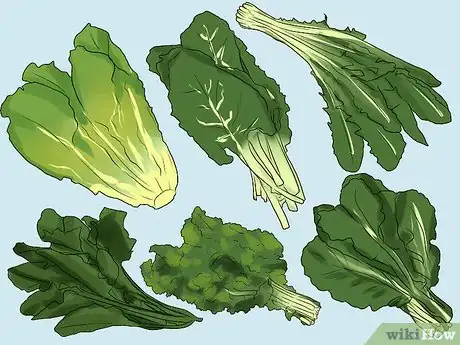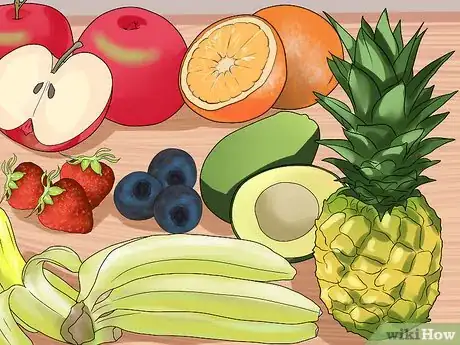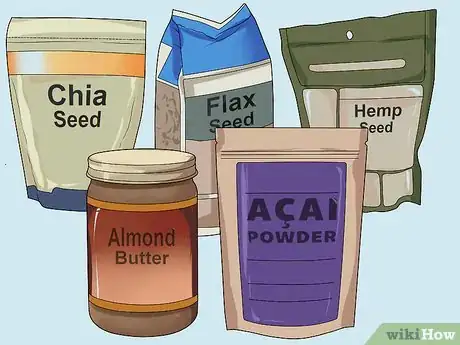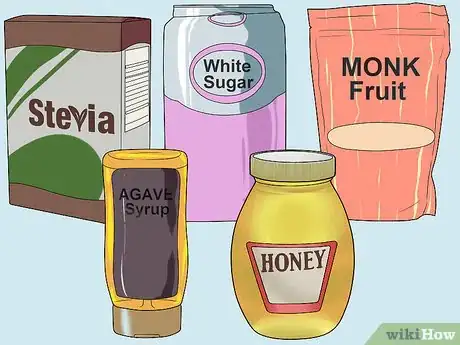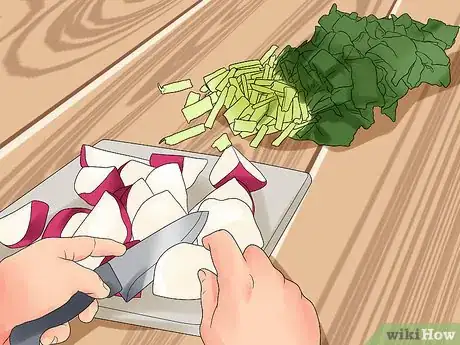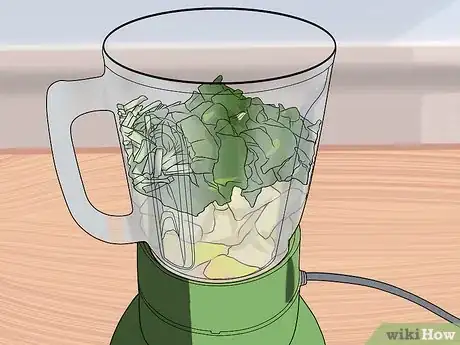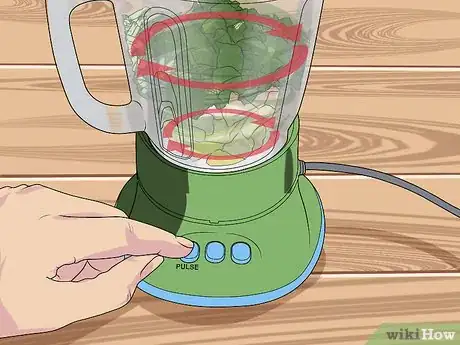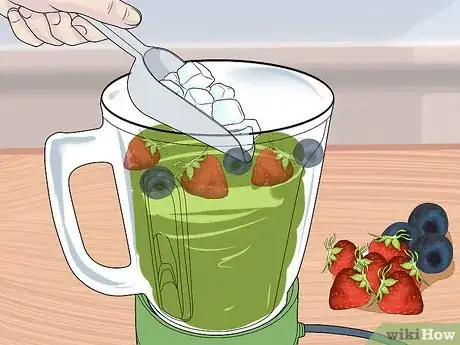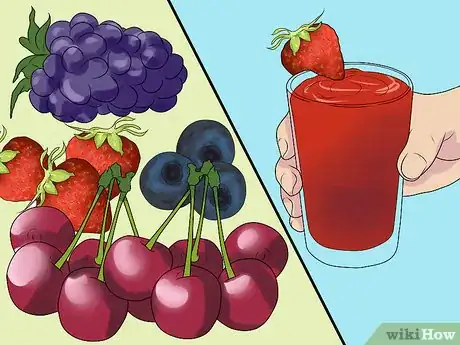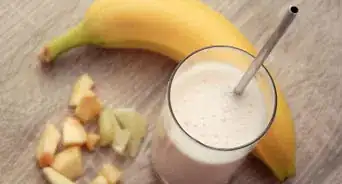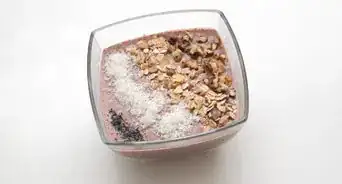This article was co-authored by Linda McNally. Linda Ingaldson McNally is a Personal Chef & Nutritionist and the Co-Founder of Sage Home Chef based in Portland, Oregon. Linda and her team specialize in personalized meal preparation and create seasonal menus to accommodate various dietary restrictions. She has extensive knowledge in nutrition relating to women's health, mindful eating, and therapeutic diets. Sage Home Chef won the AI Business Excellence Awards for Oregon's Best Healthy Cuisine Personal Chef Services and Best of Portland Personal Chef Services in 2022. Linda has a degree in Journalism, Social Justice, and Family Studies from the University of St. Thomas and earned an MS in Nutrition from the National University of Natural Medicine in Portland.
There are 13 references cited in this article, which can be found at the bottom of the page.
This article has been viewed 54,746 times.
Smoothies can be very healthy, particularly if you make your own. Green smoothies focus on greens, so they are nutrient-dense and fiber-packed. If that doesn't sound particularly tasty to you, think again. Green smoothies are packed with greens, but they feature fresh fruits to round out the flavor.
Ingredients
Serves: 1
- 1 cup (237 milliliters) of dark, leafy greens, such as kale or spinach
- 1 cup (237 milliliters) of liquid
- 1 1/2 cups (355 milliliters) of fruit (banana, avocado, strawberries, etc.)
- 1-2 tablespoons (30-60 milliliters) of power-house toppings (nut butters, ground flax seed, oatmeal, etc.)
- Sweetener to taste (honey, agave syrup, alternative sweeteners)
Steps
Picking Your Ingredients
-
1Choose your greens. You can use any combination of leafy greens you want, as long as they make approximately 1 cup (237 milliliters). Choose from spinach, kale, collards, romaine, Swiss chard, and dandelion, just to name a few. These provide the nutritional base of the smoothie.
- Dark, leafy greens are denser in nutrients than lighter-colored lettuce varies.
- The best leafy greens to use in smoothies are spinach, kale, and collard greens as they are milder in taste and will compliment your smoothie flavors better.
-
2Pick a liquid. Liquids are important with a smoothie. If you don't add a liquid, your smoothie will be much too thick. You can use something as simple as a cup of water. However, you can also use almond milk or soy milk,[1] as well as coconut milk or water. You can even use regular milk or coffee.[2]
- Use the same amount of liquid as you use greens, 1 cup (237 milliliters).
Advertisement -
3Choose your fruits. Fruits give the smoothie flavor and sweetness, and they also add additional nutrients. You can use any combination of fruit you want, including bananas, strawberries, blueberries, mango, orange, apple, pineapple, and avocado.
- You'll need about 1 1/2 cups (355 milliliters) of fruit.
- Consider adding both a creamy fruit and a flavorful fruit. For instance, avocado and banana are creamy and mango is thick and pulpy, while orange, pineapple, and strawberry add a punch of flavor.[3]
- Frozen fruit is a great addition to smoothies. It's cheap, and you can just throw it in frozen. However, be sure to use about equal parts frozen and fresh fruit, as you don't want your smoothie too cold or thick.[4]
-
4Add a booster. You can also add power-house toppings for other nutrients and protein. For instance, you can use chia seeds, flax seeds ground in a coffee grinder, almond butter, hemp seeds, or acai powder. Add a dash of cinnamon or cocoa powder for flavor.
- You can also use oats that have soaked overnight or fresh ginger.
- Cardamom, nutmeg, and tumeric can all add nice flavors. Don't forget a small dash of salt to brighten flavors.
-
5Pick sweeteners as desired. You can really use any sweetener you want, if you prefer your smoothie a little sweeter. You can add honey, agave syrup, monk fruit sugar, regular white sugar, stevia, or a splash of fruit juice, to your taste.
Blending the Smoothie
-
1Put the liquid in first. The liquid goes in first so that everything else has something to blend in. Pour it in the blender, and then add all the other ingredients on top of it. Remember, your liquid and greens will be a one-to-one ration, so you'll need about a cup of liquid if you're using a cup of greens.[5]
-
2Chop your greens and fruits. Chopping will get all the bits blended up more easily. Chop them into about 1-inch (about 2 1/2 centimeters) pieces or smaller.[6]
-
3Add the fruit and greens next. The fresh fruit should go in with the liquid. If you're using any frozen fruit, save it until a bit later. Add in the chunks of both the creamy and flavorful fruits you're using; you don't need to distinguish between the two.[7] The greens should go on top of the fruit, as it will help keep it from bogging down the blender.[8]
- Or, you might mix only the greens and liquid first until smooth, then add in the fruit. You can experiment to see what works best with your blender.[9]
- Add any other ingredients on top of the greens.
-
4Pulse the mixture at first. Pulsing the mixture helps get it going. This can help break up the fruit and such, so that it won't get as bogged down. After you've pulsed it several times, you can move on to blending it.[10]
-
5Blend the mixture. Start on low at first. Like pulsing first, a low speed helps mix the ingredients together without getting them stuck to the sides. Once you've blended on low for about half a minute, you can move on to blending on high. Keep blending until everything is smooth.[11]
- If you're having trouble getting your smoothie blended, add in some more liquid, which will help it blend more smoothly.
-
6Add in any frozen fruit or ice. If you like your smoothie extra cold, you can add a bit of ice at the end. This point is also when you should add frozen fruit. Blend it all together on high until it's a mostly homogeneous mixture.[12]
-
7Adjust as needed. Your smoothie may come out too thick or too thin, so adjust it. If you find it's not pourable, add in more liquid. You can make it thicker with more frozen fruit or even greens. Blend again until you've got the right texture.
- You can add a bit of sweetener now, if it's not sweet enough.
Trying Different Combinations
-
1Make a tropical smoothie. Pick a green of your choice, then add in some tropical flavors. You could use banana, clementine oranges, and coconut water for instance, or mango, pineapple, and coconut milk. The tropical combination is a refreshing start to any day.[13]
-
2Freshen up collard greens with lime and mango. Collard greens are often overlooked, but they are just as nutrient-packed as kale or spinach. Plus, they're sometimes cheaper since they aren't as popular. Mix collard greens with mango, sweet green grapes, and a couple of tablespoons (30 to 60 milliliters) of lime. Blend in some water, almond-/coconut-milk to make it thin enough to drink.[14]
- Make sure to combine your leafy greens with a bit of vitamin C, whether from a squeeze of lime, lemon or orange juice, as vitamin C allows for better absorption of plant iron found in dark, leafy greens.
-
3Pair ginger with pear. Another winning combination is ripe pear and a small chunk of fresh ginger. Ginger will make it fresh-tasting and a bit spicy. Use kale for the greens. Add a bit of banana to make it sweeter. For the liquid, try citrus kombucha or even a ginger tea.[15]
-
4Make grapefruit the star. Grapefruit has bright flavor that will wake you up in the morning, plus it's a heavy hitter when it comes to nutrition. Mix it with spinach, a sweet variety of apple, and a bit of banana if you want it sweeter. Use water or a milk alternative to thin it out.[16]
-
5Focus on berries. Another option is to make berries the star. Use blueberries, cherries (allow time for pitting), strawberries, and/or blackberries, along with another fruit like apple or banana to sweeten it up. Try it with spinach and coconut water or water. You can also add a small handful of nuts or seeds for protein.[17]
Community Q&A
-
QuestionDo I have to add ice?
 Community AnswerIf you wish, or you could use frozen fruit and greens. You will have to add a little more liquid to make up for that, but that is it.
Community AnswerIf you wish, or you could use frozen fruit and greens. You will have to add a little more liquid to make up for that, but that is it. -
QuestionWhat is seasonal fruit?
 Community AnswerSeasonal fruit would vary depending on where you live. The fruit that is "in season" will be fresh, ripe, plentiful, and less expensive.
Community AnswerSeasonal fruit would vary depending on where you live. The fruit that is "in season" will be fresh, ripe, plentiful, and less expensive. -
QuestionWhy is the thumbnail image not green?
 RubyTop AnswererA "green" smoothie can also just be a synonym for a "healthy" smoothie, they are not always green when blended. There are some alternatives to the recipe which can alter the color of the drink.
RubyTop AnswererA "green" smoothie can also just be a synonym for a "healthy" smoothie, they are not always green when blended. There are some alternatives to the recipe which can alter the color of the drink.
Things You'll Need
- Blender
- Knife
- Cutting board
- Measuring cups and spoons
- Utensils for spooning out ingredients
- Cup for the finished smoothie
References
- ↑ http://www.incrediblesmoothies.com/green-smoothie/
- ↑ http://www.epicurious.com/expert-advice/how-to-make-green-smoothies-without-recipe-article
- ↑ http://www.incrediblesmoothies.com/green-smoothie/
- ↑ http://www.epicurious.com/expert-advice/how-to-make-green-smoothies-without-recipe-article
- ↑ http://www.blenderbabes.com/blender-babes-101/how-to-make-green-smoothies-with-a-regular-blender/
- ↑ http://www.incrediblesmoothies.com/green-smoothie/
- ↑ http://www.incrediblesmoothies.com/green-smoothie/
- ↑ http://www.blenderbabes.com/blender-babes-101/how-to-make-green-smoothies-with-a-regular-blender/
- ↑ http://www.incrediblesmoothies.com/green-smoothie/
- ↑ http://www.blenderbabes.com/blender-babes-101/how-to-make-green-smoothies-with-a-regular-blender/
- ↑ http://www.blenderbabes.com/blender-babes-101/how-to-make-green-smoothies-with-a-regular-blender/
- ↑ http://www.blenderbabes.com/blender-babes-101/how-to-make-green-smoothies-with-a-regular-blender/
- ↑ https://www.buzzfeed.com/sallytamarkin/green-is-great?utm_term=.twWaXmP2k#.dcaQzKevV
- ↑ http://www.realsimple.com/food-recipes/browse-all-recipes/collard-greens-smoothie
- ↑ https://www.buzzfeed.com/sallytamarkin/green-is-great?utm_term=.twWaXmP2k#.dcaQzKevV
- ↑ https://www.buzzfeed.com/sallytamarkin/green-is-great?utm_term=.twWaXmP2k#.dcaQzKevV
- ↑ http://www.mindbodygreen.com/0-7956/5-delicious-green-smoothies-for-beginners.html
- ↑ http://www.sparkpeople.com/resource/nutrition_articles.asp?id=1980
About This Article
To make a green smoothie, start by pouring liquid such as water, soy milk, or regular milk into a blender. Next, add chopped fruit and greens, and pulse the mixture a few times to break up the ingredients. Afterwards, blend on a low speed for 30 seconds, then switch to the high speed and blend until everything is smooth. At this point, add some ice cubes or frozen fruit if you want your smoothie extra cold, and blend until smooth. To learn how to make smoothie variations like green tropical smoothies, read on
